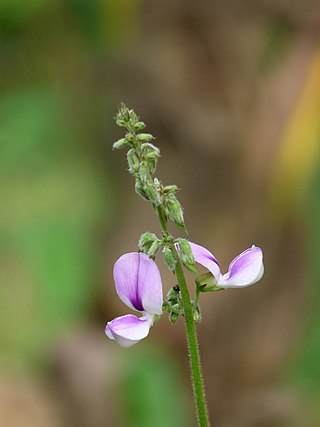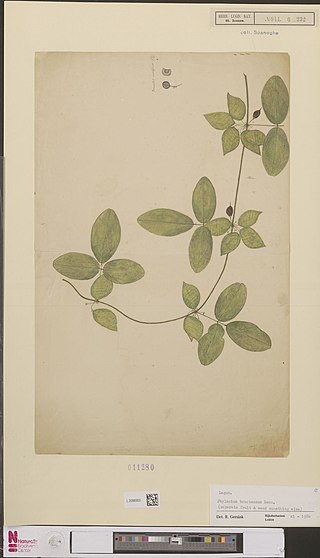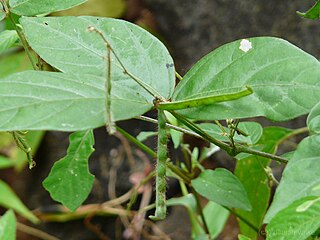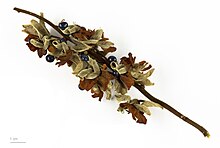
The genus Cajanus is a member of the plant family Fabaceae. There are 37 species, mainly distributed across Africa, Asia and Australasia.

Flooded grasslands and savannas is a terrestrial biome of the World Wide Fund for Nature (WWF) biogeographical system, consisting of large expanses or complexes of flooded grasslands. These areas support numerous plants and animals adapted to the unique hydrologic regimes and soil conditions. Large congregations of migratory and resident waterbirds may be found in these regions. The relative importance of these habitat types for these birds as well as more vagile taxa typically varies as the availability of water and productivity annually and seasonally shifts among complexes of smaller and larger wetlands throughout a region.

Cassia is a genus of flowering plants in the legume family, Fabaceae, and the subfamily Caesalpinioideae. Species are known commonly as cassias. The genus includes 37 species and has a pantropical distribution. Species of the genera Senna and Chamaecrista were previously included in Cassia. Cassia now generally includes the largest species of the legume subtribe Cassiinae, usually mid-sized to tall trees.

Pueraria is a genus of 15–20 species of legumes native to south, east, and southeast Asia and to New Guinea and northern Australia. The best known member is kudzu, also called Japanese arrowroot. The genus is named after 19th century Swiss botanist Marc Nicolas Puerari.
Cassia typically refers to cassia bark, the spice made from the bark of East Asian evergreen trees.

The plant tribe Phaseoleae is one of the subdivisions of the legume subfamily Faboideae, in the unranked NPAAA clade. This group includes many of the beans cultivated for human and animal food, most importantly from the genera Glycine, Phaseolus, and Vigna.

Senna, the sennas, is a large genus of flowering plants in the legume family. This diverse genus is native throughout the tropics, with a small number of species in temperate regions. The number of species is estimated to be from about 260 to 350. The type species for the genus is Senna alexandrina. About 50 species of Senna are known in cultivation.

Millettia is a genus of flowering plants in the family Fabaceae. It consists of about 169 species of shrubs, lianas or trees, which are native to tropical and subtropical regions of sub-Saharan Africa, the Indian subcontinent, Indochina, southern China, Malesia, and New Guinea. Typical habitats include tropical rain forest and seasonally-dry lowland and upland forest and forest margins, woodland, thicket, wooded grassland, and secondary vegetation.

Ormosia is a genus of legumes. 131 living species, mostly trees or large shrubs, are native to the tropical Americas, from southwestern Mexico to Bolivia and southern Brazil, to southern, southeastern, and eastern Asia, and to New Guinea and Queensland. Most are tropical, while some extend into temperate temperate regions of China. A few species are threatened by habitat destruction, while the Hainan ormosia is probably extinct already.

The flora of Australia comprises a vast assemblage of plant species estimated to over 21,000 vascular and 14,000 non-vascular plants, 250,000 species of fungi and over 3,000 lichens. The flora has strong affinities with the flora of Gondwana, and below the family level has a highly endemic angiosperm flora whose diversity was shaped by the effects of continental drift and climate change since the Cretaceous. Prominent features of the Australian flora are adaptations to aridity and fire which include scleromorphy and serotiny. These adaptations are common in species from the large and well-known families Proteaceae (Banksia), Myrtaceae, and Fabaceae.

Cercidoideae is a subfamily in the pea family, Fabaceae. Well-known members include Cercis (redbuds), including species widely cultivated as ornamental trees in the United States and Europe, Bauhinia, widely cultivated as an ornamental tree in tropical Asia, and Tylosema, a semi-woody genus of Africa. The subfamily occupies a basal position within the Fabaceae and is supported as monophyletic in many molecular phylogenies. At the 6th International Legume Conference, the Legume Phylogeny Working Group proposed elevating the tribe Cercidae to the level of subfamily within the Leguminosae (Fabaceae). The consensus agreed to the change, which was fully implemented in 2017. It has the following clade-based definition:
The most inclusive crown clade containing Cercis canadensisL. and Bauhinia divaricataL. but not Poeppigia proceraC.Presl, Duparquetia orchidaceaBaill., or Bobgunnia fistuloides(Harms) J.H.Kirkbr. & Wiersema.

Martiodendron is a genus of flowering plants in the family Fabaceae. It includes five species of trees native to northern South America, from southern Venezuela, the Guianas, and Peru to Bolivia and southeastern Brazil. Typical habitats include tropical rain forest, often periodically inundated, in both the Amazon and Atlantic forests, as well as seasonally-dry forest and wooded grassland (savanna), up to 600 meters elevation. The genus belongs to the subfamily Dialioideae.

Cologania is a genus of flowering plants in the legume family, Fabaceae. It belongs to subfamily Faboideae. It includes 13 species of perennial climbing herbs which range from the southwestern United States through Mexico, Central America, and western (Andean) South America to northern Argentina. Most species are montane, and habitats include tropical to warm temperate montane forest, woodland, thicket, wooded grassland, and open bushland on mountain slopes.

Neonotonia is a genus of flowering plants in the legume family, Fabaceae. It includes two species of scandent or climbing herbs native to sub-Saharan Africa, Yemen, India, and Sri Lanka. Typical habitats include seasonally-dry tropical forest, woodland, thicket, scrub, wooded grassland, grassland, and cultivated areas. It belongs to the subfamily Faboideae.

Phylacium is a genus of flowering plants in the legume family, Fabaceae. It includes two species of climbing herbs which range from southern China through Indochina, Malesia, and Papuasia to Queensland. Typical habitats include seasonally-dry tropical forest, thicket, wooded grassland, and scrub, often in disturbed areas. It belongs to subfamily Faboideae.
Sarcodum is a genus of flowering plants in the legume family, Fabaceae. It belongs to the subfamily Faboideae, tribe Wisterieae. Its three species are twining vines growing over shrubs, and are native from southeast mainland China to the Solomon Islands.
Tadehagi is a genus of flowering plants in the legume family, Fabaceae. It includes six species of subshrubs and shrubs native to the Indian subcontinent, Indochina, southern China, the Philippines, New Guinea, and Western Australia. Five of the six species are native to India and Indochina, and one is endemic to Western Australia. Typical habitats include seasonally-dry tropical and subtropical forest, scrub, and grassland, including rocky and riparian areas. It belongs to the subfamily Faboideae.

Teramnus is a genus of flowering plants in the legume family, Fabaceae. It includes eight species of climbing herbs and subshrubs native to the tropics of the Americas, sub-Saharan Africa, the Arabian Peninsula, the Indian Subcontinent, Indochina, Hainan, Taiwan, and New Guinea. Typical habitats are seasonally-dry tropical bushland and thicket, grassland, wooded grassland, and forest clearings, often in open and dry rocky areas.

Rhynchosia minima is a species of flowering plant in the legume family known by the common names least snout-bean, burn-mouth-vine, and jumby-bean. It can be found on every continent. It is naturalized in Hawaii.

Rhynchosia tomentosa, commonly known as the twining snoutbean is a species of plant in the legume family. It is native to the Southeastern United States, where it is primarily found in dry, open woodlands and sandhills.


















